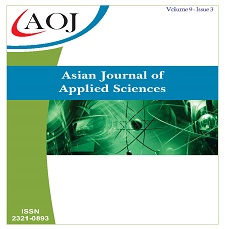Investigation of the Effect of using Salak Seeds as Coarse Aggregate in Concrete
DOI:
https://doi.org/10.24203/ajas.v9i3.6669Keywords:
Compressive strength, mixture proportion, wasteAbstract
This study described the effect of using salak seed waste as a substitute for coarse aggregate. The percentage of salak seed in concrete mixture became experimental variable to discover the best compressive strength of concrete.
Quantitative study with experimental study was carried out at the Laboratory of Materials and Concrete, Faculty of Engineering, University. The design of experiment used a designed compressive strength of concrete of 20 Mpa. The experiment consisted of five variations in the percentage of salak seeds, namely 0%, 5%, 10%, 15%, and 20%. The slump test is carried out immediately after mixing the concrete in each proportion. Furthermore, 20 pieces of cylindrical concrete samples in each treatment were tested for 7,14,21 and 28 days. This method aims to compare the strength of each of the resulting concrete compositions. The results obtained showed that the use of salak seeds with a percentage of 5% and 10% gave a compressive strength value of 28 days which met the standard compressive strength of the design female. Meanwhile, the percentage of salak seeds 15% and 20% did not produce the planned compressive strength value. Therefore, salak seeds are suitable to be used as a substitute for coarse aggregate with a percentage of less than 10%. The higher the substitution of the mixture in the salak seed concrete, the lower the compressive strength of the concrete. The results of this study can be developed in green concrete studies that use waste.
References
M. Bendixen et al., “Promises and perils of sand exploitation in Greenland,” Nat. Sustain., vol. 2, no. 2, pp. 98–104, 2019.
F. Debieb and S. Kenai, “The use of coarse and fine crushed bricks as aggregate in concrete,” Constr. Build. Mater., vol. 22, no. 5, pp. 886–893, 2008.
A. Akhtar and A. K. Sarmah, “Strength improvement of recycled aggregate concrete through silicon rich char derived from organic waste,” J. Clean. Prod., vol. 196, pp. 411–423, 2018.
E.-I. Yang, S.-T. Yi, and Y.-M. Leem, “Effect of oyster shell substituted for fine aggregate on concrete characteristics: Part I. Fundamental properties,” Cem. Concr. Res., vol. 35, no. 11, pp. 2175–2182, 2005.
B. Peceño, C. Arenas, B. Alonso-Fariñas, and C. Leiva, “Substitution of coarse aggregates with mollusk-shell waste in acoustic-absorbing concrete,” J. Mater. Civ. Eng., vol. 31, no. 6, p. 4019077, 2019.
N. K. Sharma, P. Kumar, S. Kumar, B. S. Thomas, and R. C. Gupta, “Properties of concrete containing polished granite waste as partial substitution of coarse aggregate,” Constr. Build. Mater., vol. 151, pp. 158–163, 2017.
I. O. Ogunwemimo, L. O. Salami, and A. O. Familusi, “Evaluation Of Palm Kernel Shell As A Partial Replacement For Coarse Aggregate In Concrete,” J. New Trends Civ. Eng., vol. 1, no. 2, pp. 1–4, 2019.
S. Luhar, T.-W. Cheng, and I. Luhar, “Incorporation of natural waste from agricultural and aquacultural farming as supplementary materials with green concrete: A review,” Compos. Part B Eng., vol. 175, p. 107076, 2019.
M. Abhilash, S. Jhanjhari, P. Parthiban, and J. Karthikeyan, “Axial behaviour of semi-lightweight aggregate concrete-filled steel tube columns-A DOE approach,” J. Constr. Steel Res., vol. 162, p. 105614, 2019.
M. V Chitawadagi, M. C. Narasimhan, and S. M. Kulkarni, “Axial capacity of rectangular concrete-filled steel tube columns–DOE approach,” Constr. Build. Mater., vol. 24, no. 4, pp. 585–595, 2010.
N. M. Ibrahim, S. Salehuddin, R. C. Amat, N. L. Rahim, and T. N. T. Izhar, “Performance of lightweight foamed concrete with waste clay brick as coarse aggregate,” Apcbee Procedia, vol. 5, pp. 497–501, 2013.
K. Gunasekaran, R. Annadurai, and P. S. Kumar, “Long term study on compressive and bond strength of coconut shell aggregate concrete,” Constr. Build. Mater., vol. 28, no. 1, pp. 208–215, 2012.
Downloads
Published
How to Cite
Issue
Section
License
Copyright (c) 2021 Andi Sulfanita, Gufran Darma Dirawan, Muhammad Ichsan Ali

This work is licensed under a Creative Commons Attribution-NonCommercial 4.0 International License.
- Papers must be submitted on the understanding that they have not been published elsewhere (except in the form of an abstract or as part of a published lecture, review, or thesis) and are not currently under consideration by another journal published by any other publisher.
- It is also the authors responsibility to ensure that the articles emanating from a particular source are submitted with the necessary approval.
- The authors warrant that the paper is original and that he/she is the author of the paper, except for material that is clearly identified as to its original source, with permission notices from the copyright owners where required.
- The authors ensure that all the references carefully and they are accurate in the text as well as in the list of references (and vice versa).
- Authors retain copyright and grant the journal right of first publication with the work simultaneously licensed under a Attribution-NonCommercial 4.0 International that allows others to share the work with an acknowledgement of the work's authorship and initial publication in this journal.
- Authors are able to enter into separate, additional contractual arrangements for the non-exclusive distribution of the journal's published version of the work (e.g., post it to an institutional repository or publish it in a book), with an acknowledgement of its initial publication in this journal.
- Authors are permitted and encouraged to post their work online (e.g., in institutional repositories or on their website) prior to and during the submission process, as it can lead to productive exchanges, as well as earlier and greater citation of published work (See The Effect of Open Access).
- The journal/publisher is not responsible for subsequent uses of the work. It is the author's responsibility to bring an infringement action if so desired by the author.

